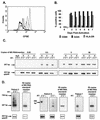Analysis of human immunodeficiency virus type 1 gene expression in latently infected resting CD4+ T lymphocytes in vivo
- PMID: 12805437
- PMCID: PMC164778
- DOI: 10.1128/jvi.77.13.7383-7392.2003
Analysis of human immunodeficiency virus type 1 gene expression in latently infected resting CD4+ T lymphocytes in vivo
Abstract
In individuals with human immunodeficiency virus type 1 (HIV-1) infection, a small reservoir of resting memory CD4(+) T lymphocytes carrying latent, integrated provirus persists even in patients treated for prolonged periods with highly active antiretroviral therapy (HAART). This reservoir greatly complicates the prospects for eradicating HIV-1 infection with antiretroviral drugs. Therefore, it is critical to understand how HIV-1 latency is established and maintained. In particular, it is important to determine whether transcriptional or posttranscriptional mechanisms are involved. Therefore, HIV-1 DNA and mRNAs were measured in highly purified populations of resting CD4(+) T lymphocytes from the peripheral blood of patients on long-term HAART. In such patients, the predominant form of persistent HIV-1 is latent integrated provirus. Typically, 100 HIV-1 DNA molecules were detected per 10(6) resting CD4(+) T cells. Only very low levels of unspliced HIV-1 RNA ( approximately 50 copies/10(6) resting CD4(+) T cells) were detected using a reverse transcriptase PCR assay capable of detecting a single molecule of RNA standard. Levels of multiply spliced HIV-1 RNA were below the limit of detection (<50 copies/10(6) cells). Only 1% of the HIV-1 DNA-positive lymphocytes in this compartment could be induced to up-regulate HIV-1 mRNAs after cellular activation, indicating that most of the proviral DNA in resting CD4(+) T cells either carries intrinsic defects precluding transcription or is subjected to transcriptional control mechanisms that preclude high-level production of multiply spliced mRNAs. Nevertheless, by inducing T-cell activation, it is possible to isolate replication-competent virus from resting CD4(+) T lymphocytes of all infected individuals, including those on prolonged HAART. Thus, a subset of integrated proviruses (1%) remains competent for high-level mRNA production after cellular activation, and a subset of these can produce infectious virus. Measurements of steady-state levels of multiply spliced and unspliced HIV-1 RNA prior to cellular activation suggest that infected resting CD4(+) T lymphocytes in blood synthesize very little viral RNA and are unlikely to be capable of producing virus. In these cells, latency appears to reflect regulation at the level of mRNA production rather than at the level of splicing or nuclear export of viral mRNAs.
Figures



References
-
- Adams, M., L. Sharmeen, J. Kimpton, J. M. Romeo, J. V. Garcia, B. M. Peterlin, M. Groudine, and M. Emerman. 1994. Cellular latency in human immunodeficiency virus-infected individuals with high CD4 levels can be detected by the presence of promoter-proximal transcripts. Proc. Natl. Acad. Sci. USA 91:3862-3866. - PMC - PubMed
-
- Bagnarelli, P., A. Valenza, S. Menzo, R. Sampaolesi, P. E. Varaldo, L. Butini, M. Montroni, C. F. Perno, S. Aquaro, D. Mathez, J. Leibowitch, C. Balotta, and M. Clementi. 1996. Dynamics and modulation of human immunodeficiency virus type 1 transcripts in vitro and in vivo. J. Virol. 70:7603-7613. - PMC - PubMed
-
- Blankson, J. N., D. Finzi, T. C. Pierson, B. P. Sabundayo, K. Chadwich, J. B. Margolick, T. C. Quinn, and R. F. Siliciano. 2000. Biphasic decay of latently infected CD4+ T cells in acute HIV-1 infection. J. Infect. Dis. 182:1636-1642. - PubMed
-
- Blankson, J. N., D. Persaud, and R. F. Siliciano. 2002. The challenge of viral reservoirs in HIV-1 infection. Annu. Rev. Med. 53:557-593. - PubMed
Publication types
MeSH terms
Substances
Grants and funding
LinkOut - more resources
Full Text Sources
Other Literature Sources
Medical
Research Materials

